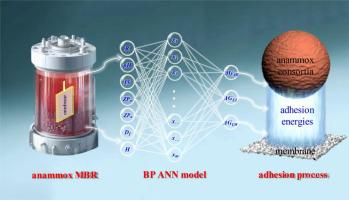当前位置:
X-MOL 学术
›
Bioresource Technol.
›
论文详情
Our official English website, www.x-mol.net, welcomes your
feedback! (Note: you will need to create a separate account there.)
Predicting thermodynamic adhesion energies of membrane fouling in planktonic anammox MBR via backpropagation neural network model
Bioresource Technology ( IF 9.7 ) Pub Date : 2024-06-18 , DOI: 10.1016/j.biortech.2024.131011 Xiang Cai 1 , Si Pang 2 , Meijia Zhang 3 , Jiaheng Teng 3 , Hongjun Lin 3 , Siqing Xia 4
Bioresource Technology ( IF 9.7 ) Pub Date : 2024-06-18 , DOI: 10.1016/j.biortech.2024.131011 Xiang Cai 1 , Si Pang 2 , Meijia Zhang 3 , Jiaheng Teng 3 , Hongjun Lin 3 , Siqing Xia 4
Affiliation

|
Predicting thermodynamic adhesion energies was a critical strategy for mitigating membrane fouling. This study utilized a backpropagation (BP) neural network model to predict the thermodynamic adhesion energies associated with membrane fouling in a planktonic anammox MBR. Acid-base (), electrostatic double layer (), and Lifshitz–van der Waals () energies were selected as output variables, the training dataset was collected by the advanced Derjaguin-Landau-Verwey-Overbeek (XDLVO) method. Optimization results identified “7-10-3″ as the optimal network structure for the BP model. The prediction results demonstrated a high degree of fit between the predicted and experimental values of thermodynamic adhesion energy (2 ≥ 0.9278), indicating a robust predictive capability of the model in this study. Overall, the study presented a practical BP neural network model for predicting thermodynamic adhesion energies, significantly enhancing the prediction tool for adhesive fouling behavior in anammox MBRs.
中文翻译:

通过反向传播神经网络模型预测浮游厌氧氨氧化 MBR 中膜污染的热力学粘附能
预测热力学粘附能是减轻膜污染的关键策略。本研究利用反向传播 (BP) 神经网络模型来预测浮游厌氧氨氧化 MBR 中与膜污染相关的热力学粘附能。选择酸碱()、静电双层()和Lifshitz-van der Waals()能量作为输出变量,通过先进的Derjaguin-Landau-Verwey-Overbeek(XDLVO)方法收集训练数据集。优化结果确定“7-10-3”为BP模型的最优网络结构。预测结果表明热力学粘附能的预测值与实验值高度吻合(2≥0.9278),表明本研究模型具有较强的预测能力。总体而言,该研究提出了一种实用的 BP 神经网络模型,用于预测热力学粘附能,显着增强了厌氧氨氧化 MBR 中粘附污垢行为的预测工具。
更新日期:2024-06-18
中文翻译:

通过反向传播神经网络模型预测浮游厌氧氨氧化 MBR 中膜污染的热力学粘附能
预测热力学粘附能是减轻膜污染的关键策略。本研究利用反向传播 (BP) 神经网络模型来预测浮游厌氧氨氧化 MBR 中与膜污染相关的热力学粘附能。选择酸碱()、静电双层()和Lifshitz-van der Waals()能量作为输出变量,通过先进的Derjaguin-Landau-Verwey-Overbeek(XDLVO)方法收集训练数据集。优化结果确定“7-10-3”为BP模型的最优网络结构。预测结果表明热力学粘附能的预测值与实验值高度吻合(2≥0.9278),表明本研究模型具有较强的预测能力。总体而言,该研究提出了一种实用的 BP 神经网络模型,用于预测热力学粘附能,显着增强了厌氧氨氧化 MBR 中粘附污垢行为的预测工具。















































 京公网安备 11010802027423号
京公网安备 11010802027423号